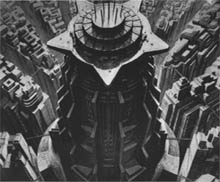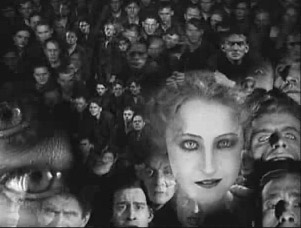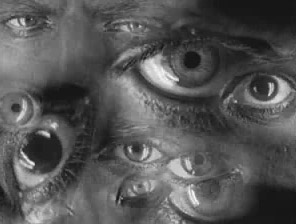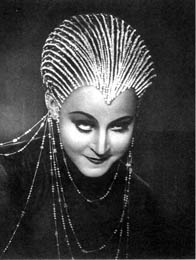| Release List | Reviews | Price Search | Shop | Newsletter | Forum | DVD Giveaways | Blu-Ray/ HD DVD | Advertise |
| Reviews & Columns |
|
Reviews DVD TV on DVD Blu-ray International DVDs Theatrical Reviews by Studio Video Games Features Collector Series DVDs Easter Egg Database Interviews DVD Talk TV DVD Talk Radio Feature Articles Columns Anime Talk DVD Savant HD Talk Horror DVDs Silent DVD
|
DVD Talk Forum |
|
|
| Resources |
|
DVD Price Search Customer Service #'s RCE Info Links |
|
Columns
|
 |
A Museum revival:METROPOLIS
|
||||
Savant interrupts his dose of DVD reviews to take in THE screening of 2001 - a new digital restoration from Germany of a silent classic. On DVD, there are several pitiful versions available of Metropolis, and one good PAL disc of the interesting Munich restoration from the early '80s. Giorgio Moroder's 1984 disco reworking is now almost extinct, existing in rights limbo and remembered, for better or worse, only for its music. Like thousands of fans the world over, starting with aficionado Forrest J. Ackerman and continuing right down to the last film student confused by the incompleteness and poor quality of previous editions, Savant has desired the opportunity to see a decent copy of Metropolis for most of his life. In a nutshell, the restoration story of Metropolis: by the early 1930s, the original negative was gone. Paramount had imported the title but had cut huge sections out of it, and rewritten its intertitles to 'simplify' its story, an effort that just made it more confusing. A bowdlerized version was concocted in Germany in the 30s by assembling outtakes to replace missing material, which helped garble even more of the story: this is the version that's existed on 16mm in the public domain for all this time. Moroder's so-called 'restoration' helped keep up the popularity of the title but was a step backwards in true restoration: besides tinting scenes and changing the running speed, he reedited parts of the film to his own taste. The Munich restoration assembled elements from archives all over the world, including some rare scenes found in Australia. This is the PAL DVD currently available, a good restoration that is nonetheless hampered by gross deficiencies in some of its source materials, which are uncorrectable through normal photochemical printing methods. Scratches, blotches, and missing frames were the 'small stuff', compared to the jittery visuals of some shrunken scenes, and the bad composition and contrast of others that had been poorly copied by optical printers long ago. We didn't know what to hope for last night at LACMA, and Savant was pleased to be in an audience absolutely thrilled by a Metropolis we'd never seen before. With very few exceptions, the print looked spotless. Beautiful new intertitles were added in German, with helpful translations via live microphone. Composer/musician/silent film music authority Robert Israel provided a live organ accompaniment with his adaptation of the original score, which was a breath of fresh air after decades of re-interpretation. But the revelation was the look of the film itself - if this is what digital restoration can do to mangled & decayed silent films, it's the best possible use of the technology. The matching between scenes from disparate sources and gauges is remarkable - the whole film has the gray-on-gray look of the expressionist masterpieces of the period, free of contrast fluctuations, dupe haloes, jumping frame lines or dirt of any kind. And this is perhaps also the first time that the full continuity of the film was presented. A different style of intertitle card was used for missing scenes that flesh out the story of Joh Fredersen's technological duel with his arch-enemy Rotwang, the mad alchemist. There are still quite a few missing parts; the true original running time is said to have been three hours! Almost every scene has new shots, extended shots and new details that make the story more fluid and comprehensible. People no longer pop around rooms or disappear in mid-scene; and because the film is projected at its proper sub-sound speed, the action scenes are no longer a comedic blur of frantic figures dashing about. 
As an example, I'll describe just one restored sequence that features the 'Maschine-Mann' Maria. She's never called a robot in the intertitles - that was a coined term from a Czech play. She performs a sexually intoxicating dance to seduce the rulers of Metropolis, a scene that is no longer a collection of unrelated angles, but instead a complex sequence intercutting Freder's fever dreams back in his sickbed, with Apocalyptic prophecy. Freder first heard the prediction of a demonic woman in scarlet, in a cathedral adorned with statues of the Seven Deadly Sins; now he imagines another character reciting the same fearsome lines at the foot of his bed. This makes the abstracted images of the False Maria gyrating, a vision filtered through Freder's fevered mind - he fractures the shots of the crowds of excited bachelors into frightening collages of staring eyes and pursing lips. In previous versions, the shots of the Seven Deadly Sins coming to life had no connection; here they are part of the prophecy. Disappearing from their sconces in the Cathedral, they replace the Nubian bearers holding up the spangled throne on which the Scarlet Maschine-Seducer stands (a detail Savant never noticed until now!), an effect which makes the whole tableux a unified nightmare. Even though some shots are missing (the prophecy spoken at the end of the bed), many more are restored, including some lightning-fast cutting bewteen giant eyes, the haughty False Maria, and Death's sweeping scythe, that puts modern montage cutting to shame. The plot of Metropolis will always have its oversimplifications and sentimental excesses, but now at least it all makes sense. Previous reworkings of the intertitles made it seem as if Fredersen and Rotwang are working as a team, and that the 'robot' Maria goes out of control because she is inherently evil, a common m.o. for artificial beings in expressionist films. The further elaboration of the plot exposes the depth of Rotwang's hatred for Fredersen. Rotwang is so obsessed with Hel (pronounced, 'Hile'), the woman he and Fredersen both loved, that he has made the Maschine Mann to replace her, losing his right hand somewhere in the process. It is Rotwang who controls the Maschine Mann. He does allow the False Maria to serve as an agent-provocateur for Fredersen, inciting the workers to rebel as a way of justifying plans for further repression.  But Rotwang's real purpose is to destroy Fredersen, by taking away his city and his son, Freder. In the madness that consumes the city, the alchemist-inventor Rotwang goes mad himself, confusing his prisoner, the true Maria, with Hel. She's freed during a (not restored) fight between Rotwang and the outraged Frederson. Before, Rotwang's strange spaced-out pursuit of Maria was a major puzzlement; now it is revealed that his derangement is augmented by his fight with Frederson, and he's not sleepwalking, but stunned. The upshot of this restoration is that the thematic roots of Metropolis seem more based in myth than in what passes for 20th Century Science Fiction. Before, the only trace of the mystical were some graphic elements and things like Rotwang's fairytale house and the pentagrams in its decor. Now Metropolis seems more than ever a collision of the ancient and the modern. As political theory, it is indeed rashly unsophisticated, as H.G. Wells complained so bitterly. As visionary art about the suppression of peoples and the use of technology to control men's destinies, Metropolis is a conceptual masterpiece that has never been bettered. The digital restoration of Metropolis makes Fritz Lang's monumental visuals look even better than before. The matte work and superimpositions, giant models, stop motion animation, are superb and often hard to detect. The magical electrical scene where the Maschine-Mann is given Maria's likeness, has visual tricks in it that have still not been bettered. It and all of the complicated split-screen sequences, including the rhythmical titles and those multi-image collage shots (there are more, dazzling instances of these you've never seen before!), were all done in the camera, by exposing the film, and winding back and exposing it again! Now we can finally appreciate this colossus. If this restoration makes it to DVD (please!) it will be a major video event. If you can see this movie on a revival screen by all means do - Metropolis is cleverly designed to look BIG, even though it's a flat 1:33 film. The German archivist who introduced the picture last night gave the disclaimer that the print he was showing us was not as perfect as it could have been in density and grain. Fooled me. He also hinted that yet additional unseen material has already been found, and that the restoration of Metropolis might be an evolving process. 2001 has been a great year for Science Fiction.  Thanks to Aitam-Bar Sagi for the use of his Metropolis images. His Metropolis Reconstruction Site has some excellent research on the film.
Review Staff | About DVD Talk | Newsletter Subscribe | Join DVD Talk Forum |
|
| Release List | Reviews | Price Search | Shop | SUBSCRIBE | Forum | DVD Giveaways | Blu-Ray/ HD DVD | Advertise |






